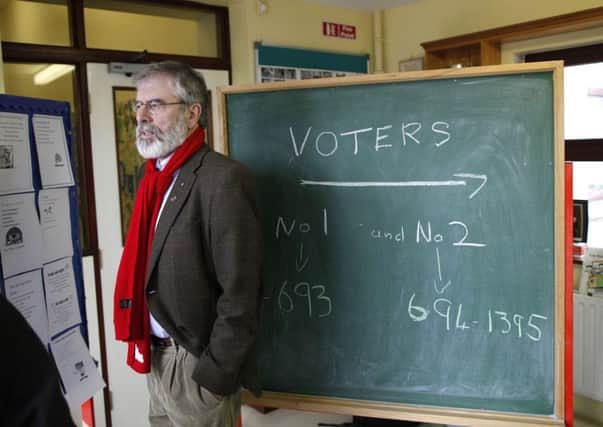Two million voters go to polls in Republic election


As polling stations closed at 10pm last night political parties were estimating around two-thirds of the 3.3 million-strong electorate had voted.
Turnout was uneven across the regions with booths in rain-sodden parts of Cork and Waterford much less busy than other areas during the day.
Advertisement
Hide AdAdvertisement
Hide AdReports also suggest that turnout in urban areas was down on the 2011 general election, when it was 70 per cent nationally.
Counting was due to begin around first light this morning.
As the electorate increasingly turns away from mainstream parties to smaller factions and independents, a hung parliament is widely predicted.
Such is the voter schism it threatens to blow apart a duopoly enjoyed for more than 80 years by the currently ruling Fine Gael party and the main Opposition party Fianna Fail.
Bitter rivals since Ireland’s civil war – despite little significant difference in their conservative policies – the pair who swapped power for generations may be forced into a historic “grand coalition”.
Advertisement
Hide AdAdvertisement
Hide AdThe coupling would have been unspeakable among their rank and file just years ago but is now hotly tipped by pollsters and pundits as the odds-on favourite outcome.
The tectonic shift could also open a definitive right/left divide in Ireland’s parliament, the Dail, for the first time since the foundation of the State.
Opinion polls show little chance of the outgoing Fine Gael/Labour coalition being returned to power on their own.
After five years of bruising austerity, Labour would need to defy predictions of big losses at the ballot box to help make up the numbers.
Advertisement
Hide AdAdvertisement
Hide AdOther possibilities include a minority Fine Gael government, supported by arch-enemies Fianna Fail, or a rainbow coalition of Fine Gael, Labour and some smaller parties.
Once a clear picture emerges from the weekend counting of votes, the parties will have until March 10 – when the Dail is scheduled to resume – to forge a power-sharing deal.
The spectre of a second election will loom over any uncertainty.
Despite being the shortest general election campaign in Irish political history, it was a drawn-out, lacklustre three weeks that generally failed to ignite the imagination of the population.
Advertisement
Hide AdAdvertisement
Hide AdMore than 550 candidates are fighting in 40 constituencies for just 158 Dail seats.
With eight fewer seats than last time around, the competition will be particularly intense in some constituencies who are down a representative.
Islanders off the coasts of Donegal, Mayo and Galway voted on Thursday to make sure their ballots were back in time for the count.
Sinn Fein president Mr Adams said he was not taking the election for granted as he arrived at the Dulargy National School polling station in Ravensdale, Co Louth.
“We stand on our record and we call upon people to come out,” he said. “There’s no point not voting – if you don’t vote it’s a sure vote for the establishment parties.”